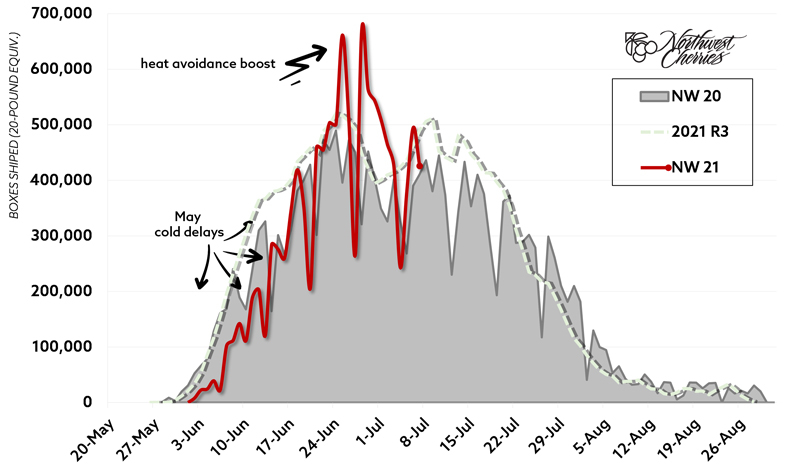Heatwaves in north-west USA and in British Columbia, Canada have affected this year's cherry crop.
Daytime and overnight temperatures were well above average and lasted for several days, leading to changes in the cherry harvest.
Night picking under lights has been one of the strategies to help minimise possible heat damage.
And as forecasts were for a run of several hot days, harvesting started before the projected picking date in order to remove any good quality fruit before conditions worsened.
Although packers experienced higher waste, cherries coming to Australia from the USA are of good quality. Rainiers and white/blush cherries seemed to be more affected than the dark cherries because they show more imperfections.
Aussie growers familiar with heat-waves
Australian cherry growers from Hillston to Hobart, and from Wandin to Wangaratta are no strangers to these kinds of conditions.
Perhaps this is a good time to look through this publication again: Understanding and managing the risks and opportunities from climate change on cherry production by South Australian Research and Development Institute (Sustainable Systems). DAFF project R1#087. Thomas DS, Hayman P, James P. (2012).
It is important that we learn the lessons from each other in a world where we see two crops of cherries in one year—from the northern and the southern hemispheres.
Heatwave report from Northwest Cherries
The comments below are from B. J. Thurlby from Northwest Cherries, and are reproduced here with thanks to Mark Baker of Produce Marketing Australia.
“Growers are amazingly resourceful, but Mother Nature is always in charge. And she has certainly continued to force changes to the cherry crop’s volume dynamics this season.
When we began these reports back in early June, we were reporting an expected delay in daily shipment volume increases due to the cooler-than-typical weather in May. As we detailed in this update, this past week has seen the other side of the coin, with most growing regions nearing or surpassing their all- time record high temperatures.
Aside from the effects on people and the cherries, such excessive heat can delay fruit development just as much as cooler weather. The Growing Degree Day charts we use in our pre-season tracking include both a minimum temperature, which a tree requires to become active, as well as a maximum temperature, at which point most cherry trees will shut down until the orchard temperatures cool.
With that in mind, the forecasted duration of this heat wave encouraged growers who were close to harvest to begin picking before their fruit was subjected to the heat. Such an upward shift in volume will have an eventual impact on the overall daily potential curve, but should not effect promotional opportunities or timing.
So while some more fruit arrived at the optical sorters before we would have otherwise expected, we also have to look at what happened to the fruit that remained in the orchards.
To be clear, the Northwest did lose some cherries due to the extreme heat. Cherries on the perimeter of the trees were more greatly impacted than fruit within the canopies. Thankfully, many growers were able to mitigate the worst of the heat with over-orchard netting and under-canopy sprinklers and thus were able to save much of their fruit. And at this point, we’ve seen no effects on green or developing cherries.
While this was certainly a new thing to experience as an industry, we come out of the other side with a little bit less fruit but a maintained momentum and our eyes on the horizon.
As we discussed last week, the Northwest heat wave that made news around the world certainly had an impact on the cherry crop. Fruit exposed to such a prolonged period of intense heat wouldn’t meet the stringent standards upheld by the Northwest growers.
Unfortunately, that means that a few growers lost some or all of their crop this season. Our hearts go out to anyone who works all year, only to see their efforts undone just before fruition.
Fortunately however, the Pacific Northwest is a big place with over 2,000 feet of elevation change across the growing regions. Together, the industry as a whole has shipped an average of 420,000 boxes per day for the past week to points around the world. Clearly, 2021 is still a cherry crop we can all get behind!”
See this article in Tree Fruit July 2021






















